The Australian SUV market has experienced a surge in new arrivals in recent years, but few brands have shaken things up as much as GWM (Great Wall Motors) and its Haval sub-brand. Once dismissed as cheap alternatives, Haval models like the H6 and Jolion have grown into credible competitors against Japanese and Korean rivals.
Now, sitting above the H6 in terms of size and price, is the new Haval H7 — also known as the Big Dog in China. It promises rugged styling, a powerful hybrid drivetrain, and heaps of cabin space. But with only one variant available in Australia — the H7 Vanther — and a drive-away price of just under $47,000, it enters direct competition with hybrid stalwarts like the Toyota RAV4, Hyundai Tucson Hybrid, and even Haval’s own H6 Plug-in Hybrid.
On paper, the H7’s specs sound compelling: almost 180 kW of power, over 500 Nm of torque, a claimed fuel economy under 6L/100km, and a big, boxy body with serious road presence. But does it deliver in reality? And more importantly, is it worth paying this much for a front-wheel-drive-only SUV?
We put the Haval H7 through a full test — design, interior comfort, infotainment, practicality, safety, performance (including 0–100, braking distance, and handling), and value-for-money verdict.
Exterior Design & Road Presence
At first glance, the H7 looks tough and rugged — far more adventurous than the softer curves of the H6. It takes inspiration from traditional 4x4s with a boxy profile, squared-off wheel arches, and upright stance.
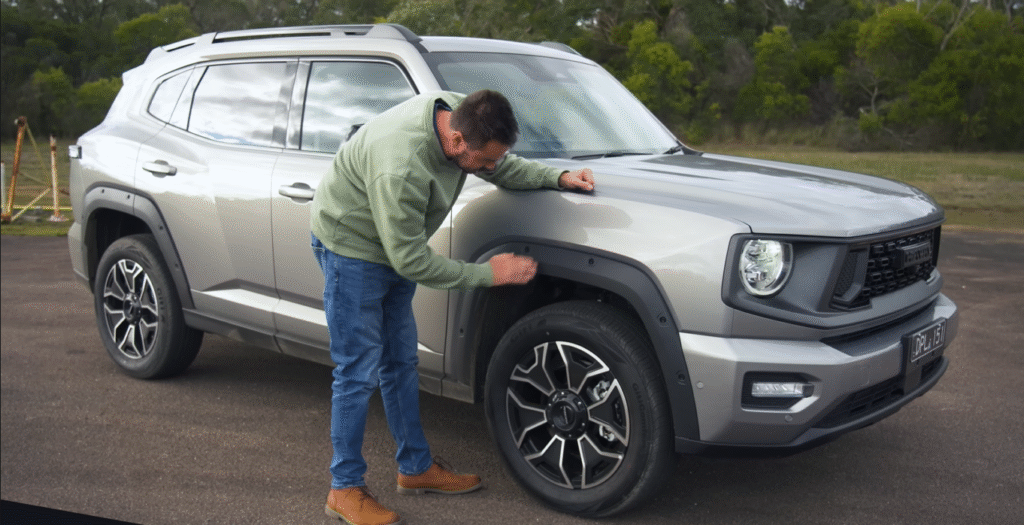
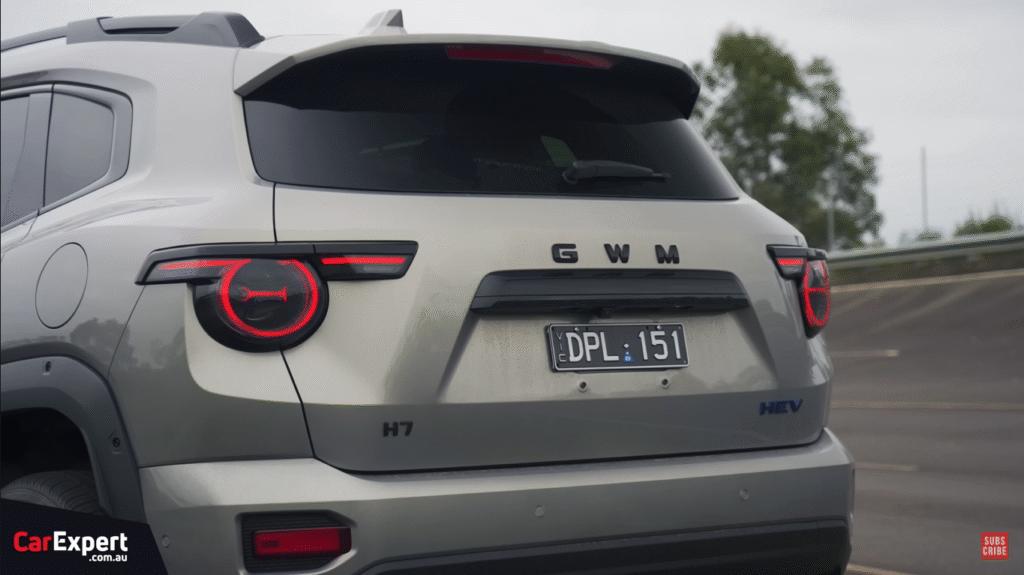
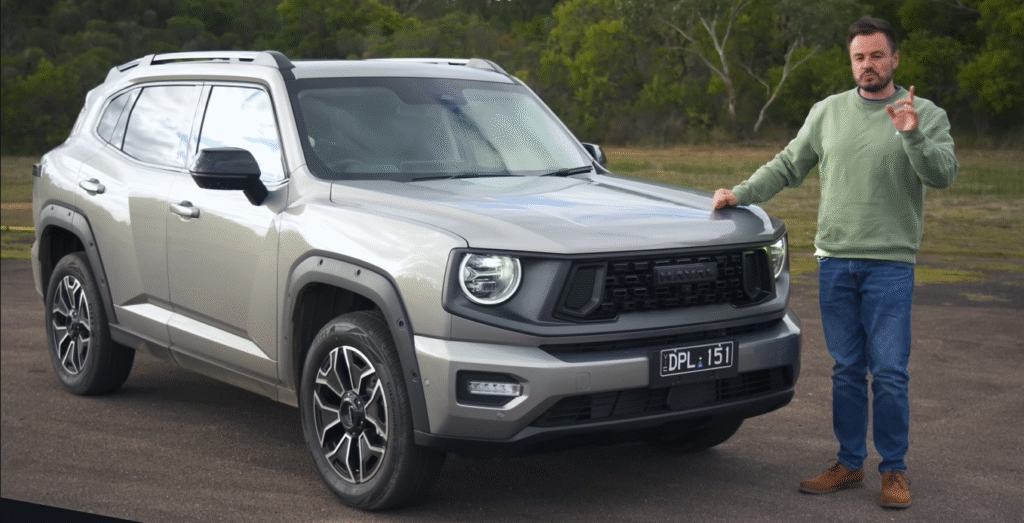
Key design highlights:
- Front fascia: Circular full-LED headlights with distinctive daytime running lights, a bold Haval badge, and an integrated 360° camera.
- Wheels: 19-inch machined alloy wheels with piano black inserts, wrapped in thick cladding for an off-road-ready look.
- Side profile: Faux bolt detailing, roof rails, privacy glass, and muscular body lines.
- Rear end: LED taillight cluster with a connecting light bar, HEV badging, and shark-fin antenna.
While it looks like an off-road SUV, it’s important to remember: the H7 is front-wheel drive only. The styling may suggest a rugged 4×4, but in reality, it’s designed more for urban roads and highways.
Verdict: Striking and unique, with genuine road presence — but styling might create expectations of capability the drivetrain doesn’t match.
Interior & Comfort
Step inside the H7, and you’re greeted with a cabin that’s… different. Unlike the “car-like” interiors of most modern SUVs, the H7 goes for a chunky, rugged theme: oversized grab handles, exposed screw-style trim, and a gear selector mounted unusually high. It feels like you’re in something closer to a mini military vehicle than a family SUV.
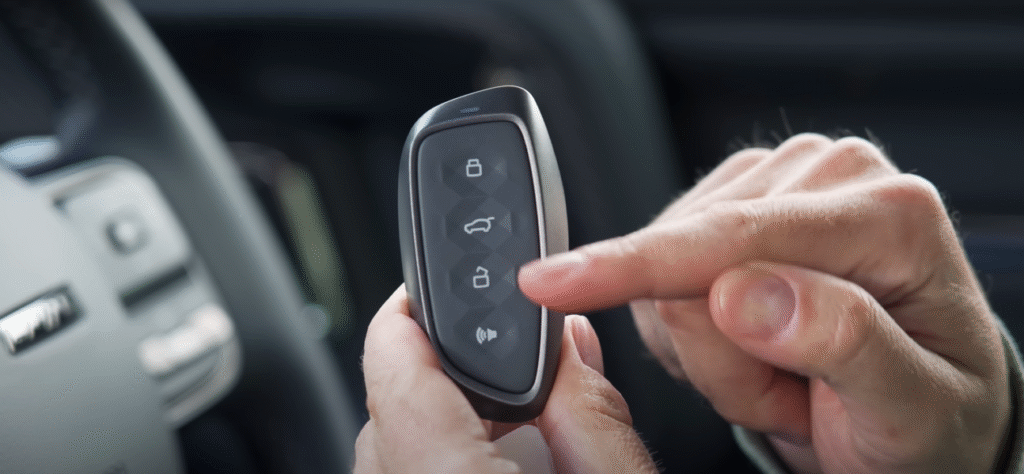
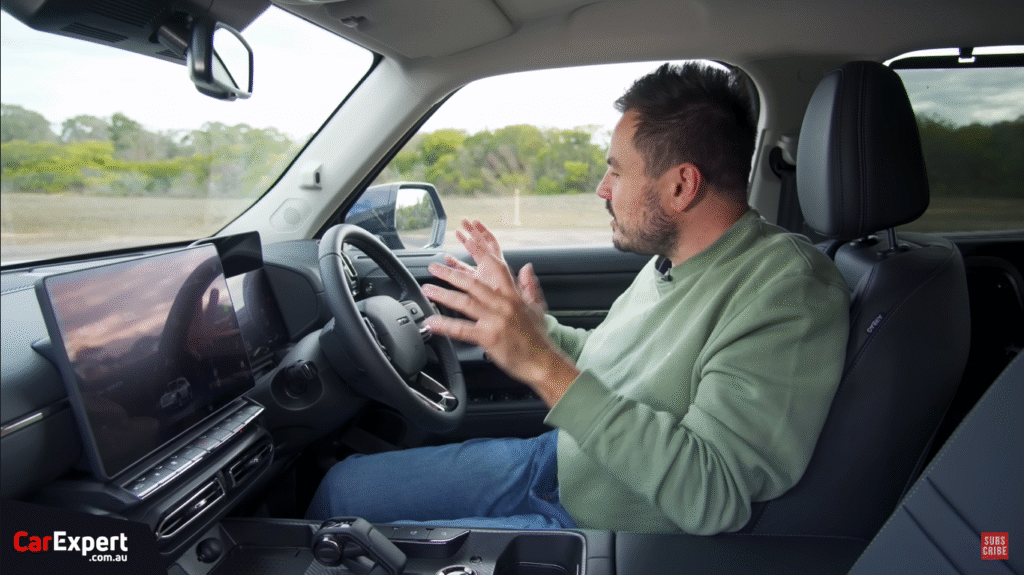
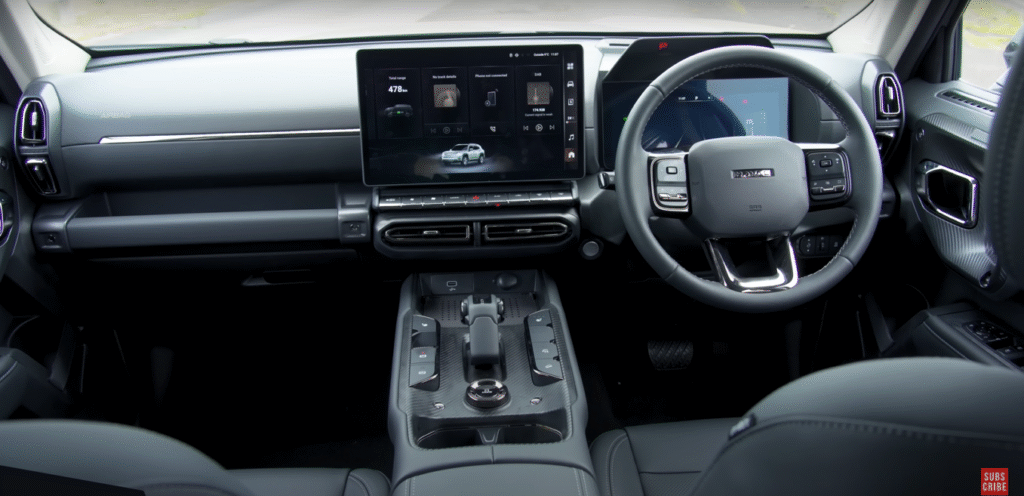
Cabin impressions:
- Space: Surprisingly roomy second row — with generous knee, toe, and headroom even for taller passengers.
- Seating: Electric adjustment, lumbar support, heating and cooling functions up front. No memory function, but decent ergonomics.
- Materials: Mostly soft-touch plastics in key areas, though some harder trims where elbows rest can get uncomfortable.
- Ambience: Cabin feels dark and could use brighter interior color options.
The panoramic glass sunroof helps open up the space, while manual rear sunshades add practicality.
Comfort verdict: Seats are supportive but not class-leading; ride comfort helps make up for it. For families, the second row is a strong selling point.
Infotainment & Technology
The H7 gets a 14.6-inch central infotainment display paired with a 10.25-inch digital driver’s cluster. On paper, it looks competitive, but execution is a mixed bag.
Strengths:
- Wireless Apple CarPlay & Android Auto support.
- Full-width smartphone integration on the large display.
- Decent 360° camera quality with multiple views, including a clear chassis view.
- Head-up display included.
Weaknesses:
- No built-in satellite navigation — you’ll rely on your phone.
- Screen brightness is poorly tuned — overly bright at night, too dim in daylight.
- Laggy response in wireless CarPlay/Android Auto.
- Basic 8-speaker sound system (unbranded).
- Climate controls buried inside menus — clumsy compared to physical knobs.
Verdict: Functional but not polished. Rivals like the RAV4 Hybrid and Hyundai Tucson offer slicker, more user-friendly infotainment.
Practicality & Storage
For families, practicality is often the deciding factor — and the H7 delivers solid but not class-leading utility.
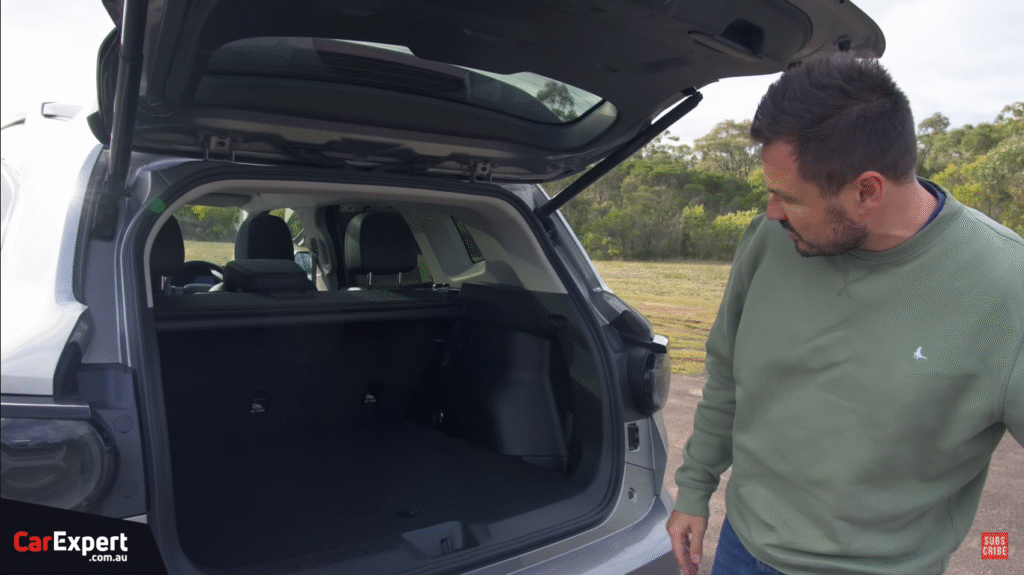
- Boot space: Just under 500L with seats up, expanding to ~1,400L with seats folded.
- Underfloor storage: None — hybrid battery and 12V battery occupy the space.
- Spare wheel: Only a tire repair kit.
- Connectivity: 2x USB-A ports, 12V outlet, wireless charging. Surprisingly, no USB-C.
- Extras: Large cooled center console, sunglasses holder, and manual rear blinds.
Verdict: Good family practicality, but limited by hybrid battery packaging and lack of USB-C.
Safety & Driver Assistance
The H7 packs a long list of active safety tech — but execution needs work.
Safety features include:
- Adaptive cruise control
- Autonomous emergency braking (AEB)
- Lane-keeping assist
- Blind-spot monitoring
- Parking sensors + 360° camera
Real-world issues:
- Lane-keeping assist drifts too close to the line, feels poorly calibrated.
- Overactive driver attention warnings (“keep eyes on road”) even when attentive.
- Indicator stalk sometimes fails to cancel.
- Rear visibility is poor — narrow window and thick seat backs block view.
Verdict: Safety features are abundant but frustrating in execution. Needs better calibration for Australia.
Engine, Performance & Driving Experience
Under the bonnet lies the heart of the H7’s appeal — a hybrid drivetrain combining petrol and electric power.
Specs:
- 1.5L turbocharged petrol engine: 110 kW / 230 Nm
- Electric motor: 130 kW / 300 Nm
- Combined: ~180 kW, 500+ Nm
- Drivetrain: Front-wheel drive only
On paper, over 500 Nm of torque is massive for a midsize SUV. But in practice, sending that torque through the front wheels alone causes issues.
Acceleration (tested):
- 0–100 km/h: 9.32 seconds
- 80–120 km/h overtaking: 6.82 seconds
Not slow, but slower than expected given the torque figure. The FWD setup forces the system to taper torque delivery, limiting performance.
Braking (tested):
- 100–0 km/h: 38.75 m in 2.82s
- Strong stopping distance, but brakes overheated after one emergency stop — a concern for heavy braking or towing.
Ride & Handling:
- Suspension is surprisingly well-tuned for Australian roads.
- Comfortable at highway speeds, absorbs bumps well.
- Predictable handling but noticeable body roll.
- Steering lacks feedback, feels numb.
- The brake pedal feels inconsistent due to regen + friction braking.
Fuel Economy:
- Claimed: <6L/100km
- Tested: 7.6L/100km (mostly highway) — worse than a Toyota RAV4 Hybrid.
Verdict: Smooth hybrid drivetrain, but FWD-only limits traction and engagement.
Variants & Pricing
In Australia, the H7 comes in just one variant:
| Variant | Price (Drive-Away) | Drivetrain |
|---|---|---|
| H7 Vanther Hybrid | ~$47,000 | FWD Hybrid |
For context:
- Haval H6 Hybrid: ~$40,000
- Haval H6 Plug-in Hybrid (AWD): ~$47,000
- Toyota RAV4 Hybrid: ~$46,000
- Hyundai Tucson Hybrid: ~$49,000
Verdict: Overpriced for a FWD-only SUV. The H6 Plug-in Hybrid offers more flexibility at the same money.
Pros & Cons
✅ Pros:
- Bold, rugged design
- Spacious interior with panoramic roof
- Smooth hybrid transitions
- Strong braking distance (before fade)
- Comfortable ride on Aussie roads
❌ Cons:
- Expensive vs rivals (and even H6 Plug-in)
- FWD only — too much torque for front wheels
- Poorly calibrated safety systems
- Infotainment screen brightness issues
- The brakes overheated after one emergency stop
Rivals & Alternatives
The H7 competes in the mid-size hybrid SUV segment, where competition is fierce:
| Model | Price (AU) | Fuel Economy | Drivetrain | 0–100 km/h |
|---|---|---|---|---|
| Haval H7 | ~$47K | 7.6L/100km (tested) | FWD | 9.3s |
| Haval H6 Plug-in | ~$47K | Lower | AWD | Faster |
| Toyota RAV4 Hybrid | ~$46K | ~5.0L/100km | FWD/AWD | ~8.0s |
| Hyundai Tucson Hybrid | ~$49K | ~6.0L/100km | AWD | ~8.5s |
Verdict: The H7 struggles against established rivals that offer AWD and better efficiency at the same price.
Who Should Buy the Haval H7?
The H7 is best suited for:
- Buyers who love bold, rugged styling.
- Families who want cabin space and comfort.
- Drivers who value smooth hybrid transitions over outright efficiency.
It is not ideal for:
- Those who want AWD or off-road ability.
- Efficiency-focused buyers (RAV4 Hybrid wins here).
- Enthusiasts looking for engaging handling.
Top 10 Reasons to Buy the Haval H7
Final Verdict
The 2025 Haval H7 (Big Dog) is a bold-looking, spacious hybrid SUV with a smooth drivetrain and decent real-world comfort. However, it’s let down by its FWD-only layout, inconsistent braking feel, safety system quirks, and high price tag.
At ~$47K drive-away, the H7 faces tough competition. The Toyota RAV4 Hybrid is more efficient and proven. The Hyundai Tucson Hybrid is more refined. And even Haval’s own H6 Plug-in Hybrid offers AWD at the same price.
Final Score: 7/10
A solid SUV with style and space, but overpriced for what it delivers. AWD and sharper infotainment would make it far more compelling.
9.32 seconds with launch control.
38.75 m (100–0 km/h), but the brakes overheated after one stop.
Claimed <6L/100km, but tested at ~7.6L/100km — less efficient than a RAV4 Hybrid.
Author Section: Paul Maric reviews every new car on the market, busts car myths, covers the latest car tech and answers your burning questions. Whether you need new car advice, purchase validation or simply love learning more about new cars and technology, we are your car experts.
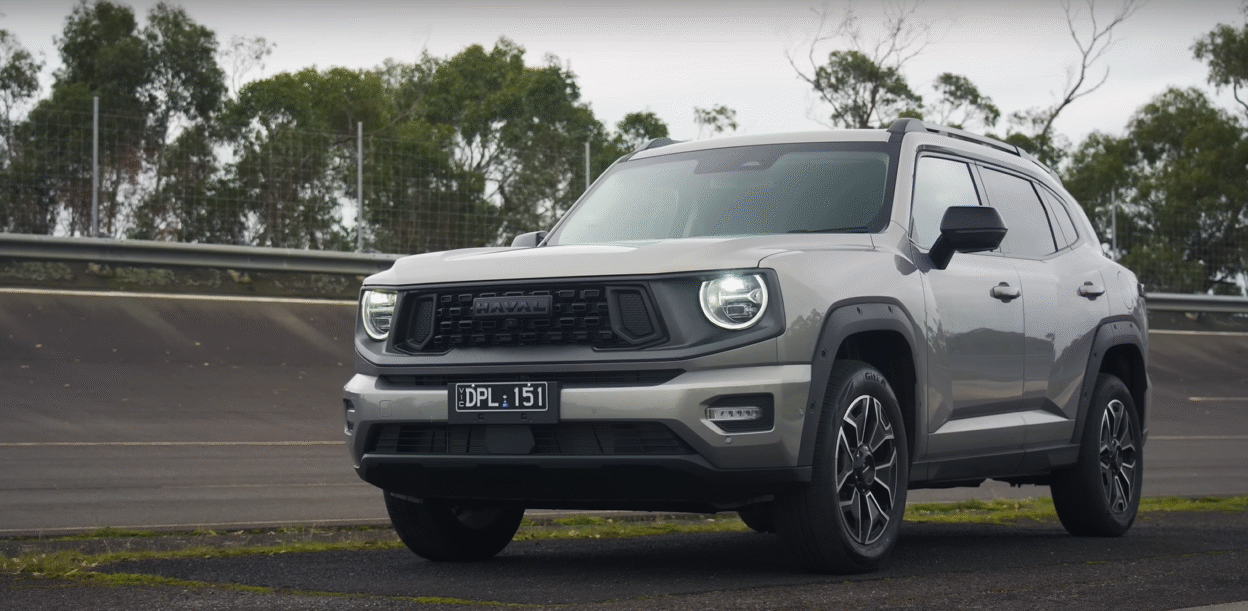
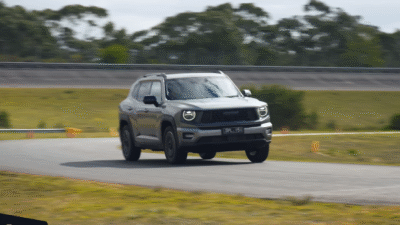
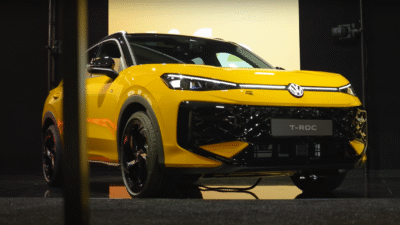
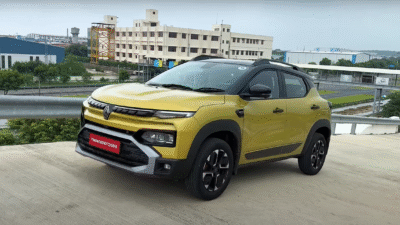
[…] you’ve been considering upgrading your car in 2025, the Haval H7 deserves a serious look. This SUV not only competes with well-known brands like Toyota, Hyundai, […]